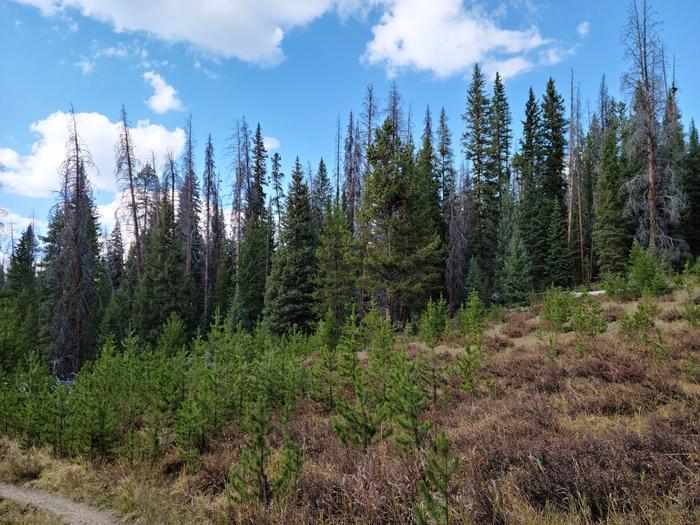Medicine Bow-Routt National Forest Christmas Tree Permit
Medicine Bow-Routt Nfs & Thunder Basin Ng
This permit allows you to cut a Christmas Tree within designated areas of the Medicine Bow-Routt National Forests for personal use. Selecting and cutting a special tree from the forest is a treasured family holiday tradition for a growing number of people. In order to conserve this forest product resource and retain scenic values, we ask for your cooperation in compliance with the regulations listed. Thank You and Happy Holidays!
Need to Know
Selecting Your Tree
The Medicine Bow-Routt National Forests have limitations on the size of the conifer trees that are permitted to be cut. See the information below to help you measure and choose a tree that meets your permit's guidelines.
Tree height: 20 feet maximum
Stump height: 6 inches maximum
Stump diameter: 6 inches maximum
Cut off any green limbs left on the stump and scatter any unwanted branches to lie 24 inches or lower from the ground.
Do not remove the top of the tree; cut down the entire tree.
If snow is on the ground, remove it from around the stump so you can accurately measure the stump and tree height.
Where to Cut Your Tree
The Christmas Tree Cutting Program on the Medicine Bow-Routt National Forests remains simple and easy to follow. The permit is valid on all Ranger Districts on Medicine Bow-Routt National Forests with the exception of exclusions listed below.
Do not cut on private land, in wilderness areas, designated campgrounds, or existing tree plantations.
Do not cut trees in or within 200 feet of any developed areas, including Campgrounds, Picnic Areas, Trailheads, Scenic Overlooks and Administrative Sites.
Do not cut trees in Timber Sale areas and do not cut any tree marked with colored paint or signs.
Do not cut trees within 100 feet of any forest road or trail.
Do not cut trees in the Thunder Basin National Grassland.
Laramie Ranger District: Do not cut trees in the entire Pole Mountain Unit, which includes Happy Jack, Tie City and Vedauwoo, and also in the Snowy Range Ski Area. Also, do not cut trees within 500 feet of Snowy Range Scenic Byway (WY Highway 130) or within 200 feet of Wyoming Highway 230.
Brush Creek-Hayden Ranger District: Do not cut trees within 200 feet of Battle Mountain Scenic Byway, WY Highway 70 and within 500 feet of Snowy Range Scenic Byway, WY Highway 130.
Hahns Peak-Bears Ears Ranger District: Do not cut trees in the Fish Creek Falls Recreation Area, the Steamboat Ski Area, the Freeman Recreation area, and the Sherman Youth Camp.
Yampa Ranger District: Do not cut trees in the Bear River Corridor within 200 feet of Forest Road 900.
Planning Your Trip
Helpful Cutting Tips
Carry your tree carefully out of the woods. Dragging the tree will rub off needles and bark. If the tree is too big to transport inside of your vehicle, wrap it in canvas to prevent wind damage.
Once home, cut the bottom of the trunk off and place the freshly cut trunk in a bucket of water. Replenish water before the tree stand is dry.
If storing your tree outside for a few days before putting it in the house, keep it in an area protected from the wind, such as the north or east side of your house or under a shaded tree.
Tools you might want to consider bringing with you include a measuring tape to ensure you select a tree that fits in your home; handsaw to cut your tree; gloves to protect your hands; boots to protect your feet; a tarp to sit on and/or to move your tree once it's cut; and rope or straps to secure your tree to your vehicle.
Choose a tree that is growing in a cluster with other trees. This will give the remaining trees more space to grow.
Leave the “perfect” trees to grow and provider a healthy genetic source for the future forest. Leave the site looking as undisturbed as possible. Please take your trash home with you.
Cut the leftover branches from the stump and scatter them.
How to Plan Your Trip
Before you leave home, be sure to measure the space where you plan to place the tree in your home (height and width), and measure the space in your vehicle where you will be transporting the tree.
There is no cell phone coverage in many areas of the forest. Expect cell service to be spotty or unavailable. Be sure someone knows where you are and when to expect you back. Bring a map with you. Don’t rely on GPS because it may not be up-to-date with forest service roads. Forest roads may be depicted as open when they are not passable due to snow, mud or fallen trees.
Check the latest weather conditions, forest warnings and road closures before you leave on your trip. Bring plenty of food and water with you as well as an overnight survival kit in case you become stranded. Dress warmly and take extra dry clothes. Expect winter weather, including cold temperatures, snow and winds. Start your day early. Be sure to find your tree and leave the woods before dark.
The Forest Service does not plow snow on National Forest system roads. Carry tire chains, shovel(s) and a tow chain. Call the local Ranger District office for road information on current conditions.
Be aware of dead trees in the forest and don’t park where your vehicle can be hit by a falling tree. Park safely on a highway pullout or off a Forest Road so that traffic can get by safely, and do not block gates. Be sure your vehicle has a full tank of gas. Bring a spare key and give it to someone else in your party. Don’t get locked out of your car!
